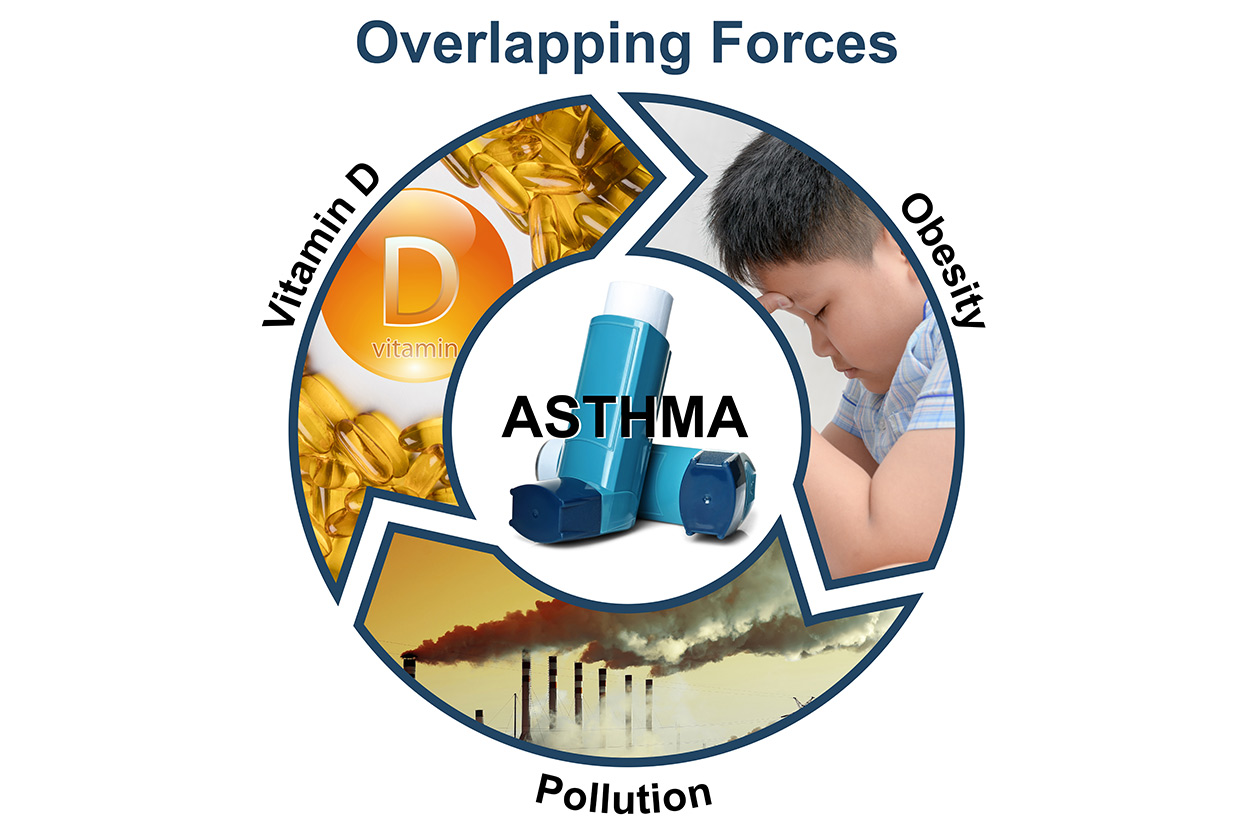A new study finds vitamin D has a protective effect among asthmatic obese children who live in urban environments with high indoor air pollution. The study out of John Hopkins University School of Medicine, funded by NIEHS, was published Feb. 11 in the Journal of Allergy and Clinical Immunology: In Practice.
 Many factors contribute to worsening asthma symptoms, such as blood levels of vitamin D, obesity, and high indoor air pollution.
Many factors contribute to worsening asthma symptoms, such as blood levels of vitamin D, obesity, and high indoor air pollution.“The research team identified many factors that make children susceptible to health problems from air pollution throughout Baltimore’s inner city,” said Kimberly Gray, Ph.D., program administrator for the Children’s Environmental Health Research Centers at NIEHS. “They’ve also taken the next step and translated their findings into practical, targeted interventions to help treat asthmatic children.”
Asthma takes a toll on urban minority populations
According to the World Health Organization, asthma is the most common childhood disease, and it disproportionately affects urban minority populations, such as black children. Higher indoor air pollution, from sources such as cigarette smoke, cooking, burning of candles or incense, and poor ventilation, is linked to greater respiratory problems that include worsening of asthma symptoms and more hospital visits.
 At Mt. Sinai, Bose is an assistant professor of pediatrics, and of medicine, pulmonary, critical care and sleep medicine. (Photo courtesy of Mt. Sinai)
At Mt. Sinai, Bose is an assistant professor of pediatrics, and of medicine, pulmonary, critical care and sleep medicine. (Photo courtesy of Mt. Sinai)“Asthma is an immune-mediated disease,” said lead author Sonali Bose, M.D., a professor at Mount Sinai, and adjunct faculty at Johns Hopkins. “From previous scientific studies, we knew that vitamin D was a molecule that may influence asthma by impacting antioxidant or immune-related pathways.”
Bose explained that at the time researchers were designing the study, they were seeing vitamin D deficiencies across the U.S. “It became very clear that African-Americans were at higher risk for vitamin D deficiency, particularly children,” she said. “We were also noticing a heavy burden of asthma in inner city minority children. It seemed as though vitamin D deficiency and asthma were coincident and interacting in some way.”
Air pollution, vitamin D, and obesity
The study tested three factors — air pollution levels in homes, blood vitamin D levels, and asthma symptoms — in 120 school-aged children with preexisting asthma in the Baltimore area. One-third of the study participants were also obese. The children were evaluated at the start of the study, and three times over the next nine months. Statistical analyses helped the researchers determine interactions between asthma symptoms and the factors of air pollution, blood vitamin D levels, and obesity.
Overall, they found that having low blood vitamin D levels enhanced the harmful respiratory effects of indoor air pollution among obese children with asthma. In homes that had the highest indoor air pollution, higher blood vitamin D levels were protective against asthma symptoms in obese children.
“What surprised us the most was that the findings of the study showed the effects were most pronounced among obese children,” Bose said. “This highlights a third factor at play here — the obesity epidemic — and helps bring that risk to light when considering individual susceptibility to asthma.”
Prevention and intervention — keys to healthy kids
Bose said they will work to identify ways to increase blood vitamin D levels in these children, helping them be more resilient to environmental insults.
 Hansel was named director of the Division of Pulmonary and Critical Care Medicine at Johns Hopkins School of Medicine on February 1. (Photo courtesy of Johns Hopkins University)
Hansel was named director of the Division of Pulmonary and Critical Care Medicine at Johns Hopkins School of Medicine on February 1. (Photo courtesy of Johns Hopkins University)“One way to increase blood vitamin D levels is to increase sun exposure, but that isn’t always possible in urban environments, or in people with darker skin pigmentation,” she said. “Another way is through dietary supplements or eating more foods that are high in vitamin D, such as fatty fish, mushrooms, or foods fortified with vitamin D, such as bread, orange juice, or milk.”
Senior author Nadia Hansel, M.D., director of the Division of Pulmonary and Critical Care Medicine at Johns Hopkins School of Medicine, also had some advice. “Another important take-home point is how the complex environment comes together to contribute to extra burden of asthma in these low-income, urban communities. Our results suggest that improving the asthma burden in the community may require a multi-faceted approach.”
Citation: Bose S, Diette GB, Woo H, Koehler K, Romero K, Rule A, Detrick B, Brigham E, McCormack M, Hansel NN. 2019. Vitamin D status modifies the response to indoor particulate matter in obese urban children with asthma. J Allergy Clin Immunol Pract; doi: https://doi.org/10.1016/j.jaip.2019.01.051 [Online 11 February 2019].
(Sheena Scruggs, Ph.D., is the digital outreach coordinator for the NIEHS Office of Communications and Public Liaison.)









